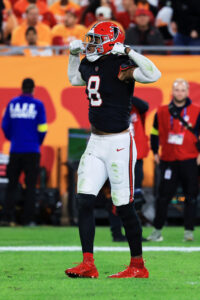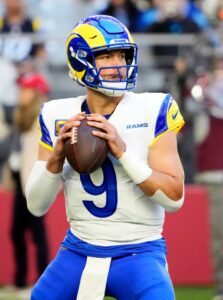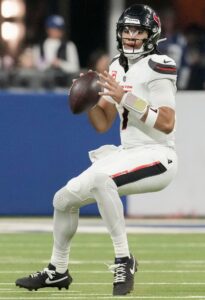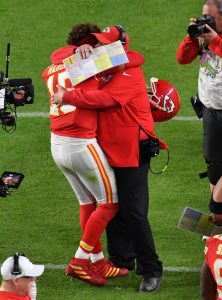2025 NFL Dead Money, By Team
As we head toward the playoffs, three NFL teams are carrying more than $100MM in dead money. That represents more than a third of the salary cap. The 49ers are also on track to make the playoffs with more than $100MM allocated to players no longer on their 53-man roster. Here is where the 32 teams stand for dead money (via OverTheCap) with three weeks left in the regular season:
- New Orleans Saints: $107.83MM
- San Francisco 49ers: $103.77MM
- New York Jets: $102.1MM
- Las Vegas Raiders: $87.79MM
- Philadelphia Eagles: $87.27MM
- Seattle Seahawks: $86.1MM
- Jacksonville Jaguars: $85.49MM
- Cleveland Browns: $83.22MM
- Miami Dolphins: $72.45MM
- Houston Texans: $66.44MM
- Tennessee Titans: $59.42MM
- Green Bay Packers: $57.98MM
- Los Angeles Rams: $56.23MM
- New England Patriots: $50.56MM
- Denver Broncos: $42.78MM
- Dallas Cowboys: $41.34MM
- Detroit Lions: $40.71MM
- Tampa Bay Buccaneers: $40.39MM
- Los Angeles Chargers: $38.78MM
- Baltimore Ravens: $38.38MM
- Buffalo Bills: $37.58MM
- Carolina Panthers: $36.55MM
- New York Giants: $33.74MM
- Pittsburgh Steelers: $33.7MM
- Minnesota Vikings: $30.6MM
- Washington Commanders: $27.29MM
- Atlanta Falcons: $27MM
- Cincinnati Bengals: $20.99MM
- Kansas City Chiefs: $20.33MM
- Indianapolis Colts: $17.37MM
- Arizona Cardinals: $16.51MM
- Chicago Bears: $8.6MM
 The $100MM trio dwarfs last year’s leaders — the Broncos — in this unwanted area. The Saints began taking some overdue medicine for their cap-gymnastics past by trading Marshon Lattimore last year. That move coming after June 1 pushed $31.67MM onto New Orleans’ 2025 cap sheet. Derek Carr also counts $19.2MM on this year’s Saints cap, while Ryan Ramczyk‘s retirement covers more than $11MM.
The $100MM trio dwarfs last year’s leaders — the Broncos — in this unwanted area. The Saints began taking some overdue medicine for their cap-gymnastics past by trading Marshon Lattimore last year. That move coming after June 1 pushed $31.67MM onto New Orleans’ 2025 cap sheet. Derek Carr also counts $19.2MM on this year’s Saints cap, while Ryan Ramczyk‘s retirement covers more than $11MM.
The Carr punishment covers $55.88MM in total, meaning nearly $37MM from the QB’s retirement will land on New Orleans’ 2026 payroll. Mickey Loomis‘ spree of restructures on that contract created that inflated figure.
Deebo Samuel brought a receiver-record dead money total to the 49ers, who absorbed $34.12MM by trading the seventh-year veteran in March. The second leg of the post-June 1 Arik Armstead transaction from 2024 created a $15MM dead cap hit this year, with void years on Charvarius Ward‘s deal covering more than $12MM.
Gang Green took on barely $20MM combined from the Sauce Gardner and Quinnen Williams trades and will do the same next year, reflecting the low signing bonus figure on the Gardner extension. The Jets, though, have taken $56MM in total from the Aaron Rodgers release ($21MM this year, $35MM next). That is the second-highest total dead cap hit in NFL history.
The team that authorized the highest dead money sum in league annals — Denver, via the 2024 Russell Wilson release — is still carrying $32MM on that contract. It comes off the books next year, and the Broncos do not have any other player counting more than $3MM in dead cap on their 2025 payroll.
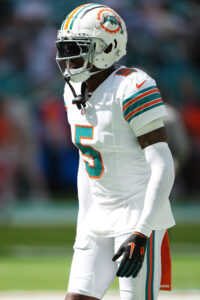 The Eagles and Seahawks are also moving toward the playoffs with higher dead money counts compared to the 2024 Broncos, though it should be noted the cap’s $24MM increase from last year plays into this. Philadelphia is still carrying a combined $26MM from the 2024 Jason Kelce and Fletcher Cox retirements. Josh Sweat void years also comprise $16.44MM of this year’s cap. The Seahawks’ D.K. Metcalf trade brought $21MM in dead cap, while Geno Smith, Tyler Lockett and Dre’Mont Jones combine to cover more than $41MM in dead money.
The Eagles and Seahawks are also moving toward the playoffs with higher dead money counts compared to the 2024 Broncos, though it should be noted the cap’s $24MM increase from last year plays into this. Philadelphia is still carrying a combined $26MM from the 2024 Jason Kelce and Fletcher Cox retirements. Josh Sweat void years also comprise $16.44MM of this year’s cap. The Seahawks’ D.K. Metcalf trade brought $21MM in dead cap, while Geno Smith, Tyler Lockett and Dre’Mont Jones combine to cover more than $41MM in dead money.
Amari Cooper and Za’Darius Smith‘s 2024 Cleveland exits via trade tagged the Browns with more than $36MM in dead money together, while the Dolphins are dealing with more than $30MM combined from the post-June 1 designations on Xavien Howard and Jalen Ramsey. The latter counts $15.7MM in dead money this year and $20.9MM in 2026. That eclipses Lattimore’s defender-record total for dead cap.
Franchise Tag Candidate: Kyle Pitts
The Falcons have only used the franchise tag three times since the NFL introduced it in 1993. With tight end Kyle Pitts a pending free agent, he could become the fourth Falcon to receive the tag during the upcoming offseason. Pitts’ late-season surge has turned it into a possibility, Ian Rapoport of NFL.com says.
Pitts entered the league with great fanfare as the fourth overall pick of the 2021 draft. The former Florida Gator became the highest-drafted tight end in league history, an honor he continues to hold. Although Pitts only caught one touchdown as a rookie, he hauled in 68 receptions for 1,026 yards. That was enough for the 6-foot-6, 250-pounder to earn a Pro Bowl nod, but he was unable to build on that during his next three seasons.
Hamstring and knee injuries limited Pitts to 10 games and 28 catches in his second year. Pitts bounced back to notch consecutive 17-game seasons from 2023-24, though his numbers were more decent than great. He averaged 50 catches, 635 yards, and approximately four touchdowns per year during that span.
The Falcons picked up Pitts’ fifth-year option after 2023, but they weren’t willing to commit to an extension entering this season. That left Pitts to play out 2025 for $10.88MM, a price tag he has justified.
With 73 catches through 14 games, Pitts has already posted a career high. He has also tied a personal best with four scores. Having amassed 797 yards with three games left, Pitts has a chance to reach 1,000 for the second time.
Thanks largely to a scintillating stretch over the past few weeks, Pitts ranks second among tight ends in yards and third in catches. The 25-year-old has piled up 24 catches and 338 yards in his past three games. He was at his best in a Week 15 upset over the Buccaneers, whom he torched for 11 receptions, 166 yards, and three touchdowns.
Pitts’ late-season dominance is what Terry Fontenot expected when he used his first draft pick as a general manager on the pass catcher. It hasn’t worked out as hoped for the Falcons, who haven’t made the playoffs since 2018. Fontenot, in charge for a half-decade, isn’t a sure bet to return in 2026 as a result.
Whether it’s Fontenot or a different GM running the show, that individual will have to decide whether to tag Pitts for approximately $15.88MM. David Mulugheta, Pitts’ agent, “hates the franchise tag,” according to Rapoport. He’d surely prefer a long-term pact. However, the Falcons may have higher priorities in running back Bijan Robinson and wide receiver Drake London. The team could lock up either or both of them on mega-deals during the upcoming offseason.
A sub-$16MM cost for one year of Pitts doesn’t look unreasonable, but the Falcons are projected to have just under $1MM in spending space in 2026, per Over the Cap. They could tag Pitts and then try to find a taker in a trade. Otherwise, they’ll need to clear more room to keep Pitts and meaningfully address other areas of their roster, potentially including quarterback.
While Pitts and backup QB Kirk Cousins have formed an excellent rapport lately, that wasn’t the case when the latter started over a larger sample in 2024. Cousins, who has taken over since Michael Penix Jr. suffered a partially torn ACL in Week 11, is a clear release candidate heading into the offseason.
Cutting Cousins would open up a sizable chuck of cap for Atlanta. It would also lead to more uncertainty under center for the Falcons, who may not have Penix at the beginning of next season. Cousins and Penix are part of an unspectacular group of starting QBs who have worked with Pitts during his time in Atlanta. Matt Ryan (at the twilight of his career), Marcus Mariota, and Desmond Ridder are the others. Not pairing up with a high-level passer has likely held Pitts back to some degree. Nevertheless, it wouldn’t be a surprise to see the Falcons place the franchise tag on him in a couple of months.
If the Falcons don’t tag or re-sign Pitts, he could wind up as the most appealing tight end on the open market. Travis Kelce, Dallas Goedert, David Njoku, and Zach Ertz are also scheduled to reach free agency. Pitts is by far the youngest member of the group. Kelce, who’s likely in Kansas City-or-retirement mode, Goedert, and Ertz are all on the wrong side of 30. Njoku will turn 30 in July, and Ertz will enter 2026 off a recent ACL tear. That’s assuming the 35-year-old continues his career next season.
Updated 2026 NFL Draft Order
Sunday’s action provided more clarity on a number of fronts relating to the playoff pushes in each conference. The list of teams still in contention for the top pick in the 2026 draft remains long, however.
Week 15 saw the Broncos and Rams clinch a postseason berth. Meanwhile, the Chiefs, Bengals and Vikings have each officially been eliminated from the playoffs. They will join the group of teams turning their attention to offseason planning. That of course includes extensive evaluation of the top prospects in this year’s class; several have already turned pro (with some exceptions).
Sunday’s results mean there are nine teams with two, three or four wins. Each of them remain candidates to secure the No. 1 selection, although victories by the Saints and Commanders yesterday will greatly hinder their chances of moving to the top of the order. Jockeying amongst teams like the Raiders, Jets and Cardinals (each on track to pursue a new quarterback this spring) will be a storyline worth following closely down the stretch.
For non-playoff teams, the draft order is determined by the inverted 2025 standings plus a series of tiebreakers, starting with strength of schedule. Playoff squads are slotted by their postseason outcome and the reverse order of their regular season record.
Here is an updated look at the first-round order:
- New York Giants (2-12)
- Las Vegas Raiders (2-12)
- Tennessee Titans (2-12)
- Cleveland Browns (3-11)
- New York Jets (3-11)
- Arizona Cardinals (3-11)
- New Orleans Saints (4-10)
- Washington Commanders (4-10)
- Cincinnati Bengals (4-10)
- Los Angeles Rams (via Falcons)
- Miami Dolphins (6-8)
- Kansas City Chiefs (6-8)
- Minnesota Vikings (6-8)
- Dallas Cowboys (6-7-1)
- Baltimore Ravens (7-7)
- Carolina Panthers (7-7)
- Detroit Lions (8-6)
- New York Jets (via Colts)
- Tampa Bay Buccaneers (7-7)
- Pittsburgh Steelers (8-6)
- Philadelphia Eagles (9-5)
- Houston Texans (9-5)
- Dallas Cowboys (via Packers)
- Buffalo Bills (10-4)
- Chicago Bears (10-4)
- Los Angeles Chargers (10-4)
- San Francisco 49ers (10-4)
- Cleveland Browns (via Jaguars)
- New England Patriots (11-3)
- Seattle Seahawks (11-3)
- Los Angeles Rams (11-3)
- Denver Broncos (12-2)
Poll: Who Will Win NFC West?
It only took 10 wins to earn the NFC West title a year ago. Two of the division’s four teams have already reached that total 14 weeks into 2025. The 10-3 Rams are in first place and on track to win the division for the second straight season, but the Seahawks share the same record. Meanwhile, the 49ers (9-4) are right on their tails. At 3-10, the Cardinals are the only non-contender in the division, leaving the other three clubs to battle for the title over the next four weeks.
The Rams rank second in the NFL in point differential, trailing only the Seahawks in that category. However, the Rams got the better of the Seahawks in their first matchup of the season in Week 11. Playing at home, the Rams took advantage of four Sam Darnold interceptions to eke out a 21-19 win. Those two will meet again in Seattle in Week 16. The Seahawks also lost their previous meeting with the 49ers, who took a 17-13 decision on the road in Week 1. Seattle will seek revenge in San Francisco in Week 18, potentially with the division at stake. Having already split their season series, the Rams and 49ers are done with each other unless a rubber match occurs during the playoffs.
Despite Darnold’s disastrous showing against the Rams last month, the 28-year-old has been terrific for the second season in a row. Between his one-off with the Vikings and his first 13 games as a Seahawk, Darnold has gone 24-6 as a starter since 2024. He’s in the MVP running this year, but Stafford is the favorite in his age-37 season.
Both Stafford and Darnold have benefited from immensely talented receivers. The Rams have a stellar one-two punch in Puka Nacua and Davante Adams. Nacua leads the NFL in catches (93), and Adams is atop the league in receiving touchdowns (14). Meanwhile, the Seahawks’ Jaxon Smith-Njigba is easily pacing the league in yards (1,428). He has a shot to break Calvin Johnson‘s single-season record of 1,964.
While their offenses have gotten most of the headlines, the Rams and Seahawks have also prevented scoring at an elite clip. The Seahawks have given up 17.4 points per game to the Rams’ 17.5. Only the Texans (16.0) have done a better job keeping points off the board than those two clubs. Rams defensive coordinator Chris Shula and Seahawks DC Aden Durde could soon draw head coaching interest as a result of their work this year.
The Rams’ Sean McVay and the Seahawks’ Mike Macdonald will likely earn Coach of the Year consideration. The same should be true for the 49ers’ Kyle Shanahan, who has kept his team in the hunt despite an absurd number of notable injuries.
The 49ers survived an extended period without starting signal-caller Brock Purdy and tight end George Kittle, who have returned from the shelf in recent weeks. They’ve also had to get by for most of the year without their two best defensive players, linebacker Fred Warner and end Nick Bosa. Warner suffered a fractured and dislocated ankle in Week 6. Bosa tore his ACL in Week 3. Without Bosa coming off the edge, the 49ers rank last in the league in sacks. Nevertheless, coordinator Robert Saleh has still cobbled together the game’s eighth-ranked scoring defense. Despite a failed run with the Jets, Saleh’s performance this season could earn him a second shot as a head coach in 2026.
The NFC West is setting up as a three-way fight to close out the season, but ESPN’s Football Power Index pegs the Rams as overwhelming favorites. They have a 56.3% chance to win the division. The Seahawks (27.5) and 49ers (16.3) are lagging well behind. How do you think it will play out? Vote in PFR’s latest poll and weigh in with your thoughts in the comments section.
Updated 2026 NFL Draft Order
Week 14’s action brought about a few notable updates to the standings at both ends of the NFL’s conferences. Another four teams are officially out of playoff contention, while wins by Tennessee and New Orleans could prove to be rather important once the campaign has ended.
The Jets, Browns, Falcons and Commanders were eliminated from the postseason through the results of recent days. Of course, each of those teams have been out of the running for a playoff push for some time now. Still, that group will be worth watching closely over the closing four weeks of the season as the top-10 order for Day 1 of the draft gradually comes into focus.
Uncertainty regarding the quarterback class of 2026 will no doubt remain a talking point over the coming months. Fernando Mendoza strengthened his case to be QB1 in April’s draft, although it remains to be seen if other top signal-callers like Dante Moore and Ty Simpson will turn pro or elect to remain in school for one more season. Decisions on those fronts will be central storylines carrying significant implications for the teams near the top of the order which find themselves in need of a quarterback investment.
For non-playoff teams, the draft order is determined by the inverted 2025 standings plus a series of tiebreakers, starting with strength of schedule. Playoff squads are slotted by their postseason outcome and the reverse order of their regular season record.
Here is an updated look at the first-round order:
- New York Giants (2-11)
- Las Vegas Raiders (2-11)
- Tennessee Titans (2-11)
- Cleveland Browns (3-10)
- New Orleans Saints (3-10)
- Washington Commanders (3-10)
- New York Jets (3-10)
- Arizona Cardinals (3-10)
- Los Angeles Rams (via Falcons)
- Cincinnati Bengals (4-9)
- Minnesota Vikings (5-8)
- Miami Dolphins (6-7)
- Baltimore Ravens (6-7)
- Kansas City Chiefs (6-7)
- Dallas Cowboys (6-6-1)
- Carolina Panthers (7-6)
- Detroit Lions (8-5)
- New York Jets (via Colts)
- Tampa Bay Buccaneers (7-6)
- Pittsburgh Steelers (7-6)
- Philadelphia Eagles (8-5)
- Houston Texans (8-5)
- Chicago Bears (9-4)
- Buffalo Bills (9-4)
- Los Angeles Chargers (9-4)
- San Francisco 49ers (9-4)
- Cleveland Browns (via Jaguars)
- Dallas Cowboys (via Packers)
- Seattle Seahawks (10-3)
- New England Patriots (11-2)
- Los Angeles Rams (10-3)
- Denver Broncos (11-2)
Poll: Who Will Win AFC South?
As a back-to-back AFC South champion, Houston entered the 2025 season as the odds-on favorite to rule the division again. While few expected either the Jaguars or Colts to seriously contend, they’re ahead of the Texans entering Week 14. With the exception of the 1-11 Titans, who may be on their way to a second straight No. 1 overall pick, the AFC South is anyone’s to win with five games remaining.
Jacksonville and Indianapolis, both 8-4, will meet on Sunday with first place on the line. They’ll also square off in Week 17. The Texans (7-5) will go on the road to face the Chiefs (6-6) in something resembling a do-or-die game for the reigning conference champions. Having already beaten the Colts in Indianapolis last Sunday, the Texans will host them in a game that could decide the division or a playoff berth in Week 18. The Texans and Jaguars split their season series. They won’t see each other again unless they match up in the postseason.
The Colts have been atop the division for most of 2025, but they dropped to second place in Week 13. Thanks in part to an unexpected resurgence from quarterback Daniel Jones, a free agent addition who previously flamed out with the Giants, the Colts stormed to a 7-1 start. They held the No. 1 seed in the AFC at that point.
Acquiring star cornerback Sauce Gardner from the Jets before the Nov. 4 deadline was supposed to bolster the Colts’ chances of at least winning the division. They’ve now lost three of four, though, and Gardner could miss multiple weeks with a calf strain. Jones is playing through a fibula injury, meanwhile, and league-leading rusher Jonathan Taylor is coming off back-to-back mediocre showings.
While the shine has come off the Colts in recent weeks, the Jaguars and Texans have surged. Despite losing prized first-round rookie wide receiver/cornerback Travis Hunter to a season-ending knee injury in early November, the Jaguars have won three in a row. They’ve succeeded despite underwhelming numbers from quarterback Trevor Lawrence and a major downturn in production from second-year receiver Brian Thomas.
The Texans have survived despite a significant injury to C.J. Stroud, who returned last week. The third-year signal-caller missed three full games with a concussion. The Texans went undefeated in that span under backup Davis Mills, who led a dramatic fourth-quarter comeback over the Jags in Week 10.
Mills’ heroics proved crucial against Jacksonville, but the Texans’ top-ranked defense is the main reason they’re still in the race. Winners of seven of nine and four straight, the Texans have a legitimate chance to become the latest team to rally for a playoff berth after starting 0-3. Only six, including the 2018 Texans, have done so since 1979.
Although Indianapolis is reeling while Jacksonville and Houston are trending up, the Colts are still slight favorites to conquer the South, according to ESPN’s Football Power Index. At 41%, they’re narrowly edging out the Jaguars (40%) ahead of Sunday’s showdown. The Texans (19%) are a distant third.
How do you expect this three-team battle to play out over the final month of the season? Vote in PFR’s latest poll and weigh in with your thoughts in the comments section.
Poll: Will Chiefs Make Postseason?
It would have been hard to fathom entering the 2025 campaign, but the Chiefs are on the outside of the AFC playoff bracket heading into Week 14. Owners of a mediocre 6-6 record, the perennial Super Bowl contenders are in 10th place in the conference with five games left in the regular season.
The Chiefs are in serious jeopardy of missing the playoffs for the first time since 2014, the second year of head coach Andy Reid‘s brilliant run with the franchise. Patrick Mahomes, now one of the greatest quarterbacks in the history of the sport, was a freshman at Texas Tech then.
The Chiefs haven’t won fewer than 11 games in a season since Mahomes took the reins in 2018. One more loss would be a career-worst total for Mahomes, and it could be a near-knockout punch for the Chiefs.
Kansas City will enter this Sunday’s game against Houston (7-5, eighth in the AFC) with a 35% chance to rally for a postseason berth, per Next Gen Stats (via Ali Bhanpuri of NFL.com). A win would increase the odds to 49%, while that figure would plummet to 11% with a loss.
The good news for the Chiefs is that they’ll play at home, where they’ve gone a dominant 63-14 in the Mahomes era. On the negative side, they’ll battle the league’s No. 1 defense with what could be a patchwork offensive line. Left tackle Josh Simmons will miss the game with a wrist injury. Meanwhile, right tackle Jawaan Taylor (triceps/knee) and right guard Trey Smith (ankle) haven’t practiced this week. Going without as many as three starting linemen may prove too much to overcome against a pair of superb pass rushers in Will Anderson Jr. and Danielle Hunter.
Looking beyond their showdown with the Texans, the Chiefs’ remaining schedule includes games against the bottom-feeding Titans (Week 16) and Raiders (Week 18). However, they’ll also face formidable opponents in the Chargers (Week 15) and Broncos (Week 17), both division rivals.
The Chiefs already lost to the Chargers (8-4) in Week 1 and the Broncos (10-2) in Week 11. It’s hard to imagine Kansas City making up enough ground on Denver to rally for its 10th division title in a row. A wild-card spot, something the Chiefs have never settled for with Mahomes at the helm, presents the more realistic path to a playoff berth.
While the Chiefs rank near the top of the league in offense (fifth), point differential (seventh), and defense (10th), coming out on the wrong end of one-score games has left them in an unenviable position. After finishing a stunning 11-0 in one-score affairs last year, regression in that department has haunted the Chiefs this season. Kansas City is 1-6 in one-score games, which isn’t lost on future Hall of Fame tight end Travis Kelce.
“I’m sure everyone is sick of us saying it, but we’re a few plays away from being a one seed in my mind,” Kelce said this week on his “New Heights” podcast with brother Jason Kelce (via Jaclyn Hendricks of the New York Post). He added that “all of the losses are within one score, and there’s a handful of plays within those games that are determining the outcome.”
The 36-year-old Kelce has been one of the faces of the Chiefs’ dynasty, joining Reid and Mahomes to win three Super Bowls and five AFC titles. Kelce, who could retire after 2025, will decide his future in the offseason. In the meantime, he and the Chiefs have little margin for error as they seek their 11th straight playoff berth.
Poll: Who Will Earn NFC’s No. 1 Seed?
The Patriots’ win Monday night gave the AFC two two-loss teams (and zero three-loss squads) exiting Week 13, forming a mid-2010s-like duel for the No. 1 seed with the Broncos. In the NFC’s race for the bye slot, the picture is much cloudier.
 As it stands, the NFC has a host of teams in contention for that No. 1 spot. The Bears currently hold it, but a fierce challenge appears ahead for Ben Johnson‘s resurgent team. Chicago sits at 9-3, but so do the Rams and Seahawks. Because of their tie in Dallas, the Packers are 8-3-1. The Eagles’ Week 13 loss to the Bears hurts their cause, but the defending Super Bowl champions are 8-4. The 49ers are 9-4, creating an interesting race with five weeks left.
As it stands, the NFC has a host of teams in contention for that No. 1 spot. The Bears currently hold it, but a fierce challenge appears ahead for Ben Johnson‘s resurgent team. Chicago sits at 9-3, but so do the Rams and Seahawks. Because of their tie in Dallas, the Packers are 8-3-1. The Eagles’ Week 13 loss to the Bears hurts their cause, but the defending Super Bowl champions are 8-4. The 49ers are 9-4, creating an interesting race with five weeks left.
The Bears have not earned a top seed since 2006, though their second-seeded squad advanced to the 2010 NFC title game. The Bears have not managed a playoff win since. ESPN’s Football Power Index gives the current NFC leader a 12% chance of holding the top spot. That figure sits fifth in the conference.
While the Johnson hire has proven the catalyst for the Bears’ climb — after four straight playoff absences — the team’s decision to overhaul its offensive line has played a big role as well. The trades for Jonah Jackson and Joe Thuney, along with the Drew Dalman signing, has helped the Bears rank second in pass block win rate and fourth in run block win rate this season. This group powered D’Andre Swift and Kyle Monangai to 100-yard days in Philly on Black Friday. The team also saw Jaylon Johnson and Kyler Gordon, whose offseason extension topped the slot cornerback market, activated from IR for the stretch run.
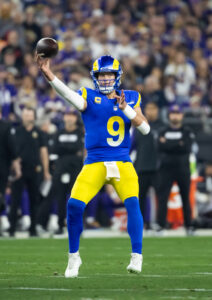 Chicago, however, closes with four games against over-.500 teams; the Bears draw the Packers twice and have games against the 49ers and Lions. In addition to the two Bears tilts, the Packers have a Denver trip to make along with a Week 17 Ravens matchup. ESPN’s FPI gives Green Bay a 17% chance to hold the No. 1 seed. The Packers earned back-to-back No. 1 seeds — in 2020 and ’21 — but have not come especially close to such real estate during Jordan Love‘s starter run.
Chicago, however, closes with four games against over-.500 teams; the Bears draw the Packers twice and have games against the 49ers and Lions. In addition to the two Bears tilts, the Packers have a Denver trip to make along with a Week 17 Ravens matchup. ESPN’s FPI gives Green Bay a 17% chance to hold the No. 1 seed. The Packers earned back-to-back No. 1 seeds — in 2020 and ’21 — but have not come especially close to such real estate during Jordan Love‘s starter run.
Love has shown more growth in 2025, ranking third in QBR despite the team battling major issues in its pass-catching corps. Tucker Kraft is out for the season, and the team has not had Jayden Reed — its leading receiver in 2023 and ’24 — available since Week 2. Reed is in the IR-return window, and the Packers have seen Christian Watson — who returned midseason from an ACL tear — step forward along with Romeo Doubs. The Pack have not seen too much from first-round pick Matthew Golden, however, and the Kraft-to-Luke Musgrave gap appears wide despite the latter being drafted earlier in 2023.
The Packers did not exactly ride defense to those bye slots earlier this decade, with that unit being unreliable for most of Aaron Rodgers‘ stay. But Jeff Hafley‘s unit ranks sixth in scoring and fourth in yardage. EPA is a bit more skeptical, slotting the Pack 14th defensively. The team’s Micah Parsons blockbuster trade/extension sequence has made an impact. Parsons’ 36 pressures trail only Myles Garrett (39) this season; the ex-Cowboy dynamo has 12.5 sacks — already just 1.5 shy of a career high.
 Concerns about Matthew Stafford‘s summer back injury were overblown, and the 17th-year quarterback is pushing for an MVP — an accomplishment that would strengthen a Hall of Fame case light on accolades. The one-time original-ballot Pro Bowler’s 32:4 TD-INT ratio has powered the Rams, who have benefited from their Cooper Kupp-to-Davante Adams upgrade. The NFL’s active touchdown reception leader (117) has a league-high 14 this season.
Concerns about Matthew Stafford‘s summer back injury were overblown, and the 17th-year quarterback is pushing for an MVP — an accomplishment that would strengthen a Hall of Fame case light on accolades. The one-time original-ballot Pro Bowler’s 32:4 TD-INT ratio has powered the Rams, who have benefited from their Cooper Kupp-to-Davante Adams upgrade. The NFL’s active touchdown reception leader (117) has a league-high 14 this season.
L.A. has also benefited from good injury fortune this season. Until Rob Havenstein‘s setback, the Rams’ O-line has rebounded from injury-plagued campaigns, with Puka Nacua also avoiding IR. Chris Shula‘s defense ranks second in points, putting him on the radar to become the third Shula appointed an NFL HC. FPI gives the Rams, who have not held the No. 1 seed since 2001, a 30% chance to do so — tops in the conference. The Rams have three games against sub-.500 teams, though they do face the Lions and Seahawks as well.
Seattle limited Stafford in a Week 11 loss, but Sam Darnold‘s four-INT day impeded a road win. The Seahawks have otherwise seen Darnold reward them for another offseason QB gamble, as they gave the nomadic QB a three-year, $100.5MM deal days after trading Geno Smith. Darnold is all but certain to collect the additional $17.5MM due in February. While Kupp has stayed healthy, he only has 438 receiving yards. Jaxon Smith-Njigba has rendered that a minor concern, as his NFL-most 1,336 have him gunning for Calvin Johnson‘s single-season record (1,964), setting up the 2023 first-rounder for a monster extension; he is eligible for a new deal in January.
Mike Macdonald‘s defense has surpassed expectations, ranking third in points allowed and EPA per play. Byron Murphy has taken a major step forward, going from a half-sack as a rookie to seven this season, while the DeMarcus Lawrence and Ernest Jones signings have paid off as well. The Hawks will need to upend the Rams to have a realistic shot at the 1 seed, and they also have games against the 49ers, Colts and Panthers. FPI gives Seattle a 16% chance at what would be its first 1 seed since 2014.
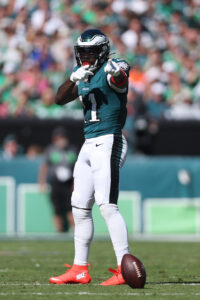 San Francisco is somehow 8-4 despite losing Nick Bosa, Fred Warner and Mykel Williams for the season — along with Brock Purdy for much of it. The recently extended starter has not played especially well, but he is not expected to be 100% after a turf toe injury until the offseason. Mac Jones‘ two-year, $7MM contract has proven to be a bargain, as the once-maligned QB has gone 5-3 as a starter this season. Jones ranks 10th in QBR. Robert Saleh‘s return has also aided the 49ers, who rank eighth defensively (though, EPA is far more skeptical, slotting Saleh’s crew 24th).
San Francisco is somehow 8-4 despite losing Nick Bosa, Fred Warner and Mykel Williams for the season — along with Brock Purdy for much of it. The recently extended starter has not played especially well, but he is not expected to be 100% after a turf toe injury until the offseason. Mac Jones‘ two-year, $7MM contract has proven to be a bargain, as the once-maligned QB has gone 5-3 as a starter this season. Jones ranks 10th in QBR. Robert Saleh‘s return has also aided the 49ers, who rank eighth defensively (though, EPA is far more skeptical, slotting Saleh’s crew 24th).
Given a 15% chance at claiming what would be their third No. 1 seed of the Kyle Shanahan era, the 49ers follow their Titans matchup with games against the Colts, Bears and Seahawks. Only one road game (Indianapolis) remains on San Francisco’s docket.
FPI gives the Eagles only an 8% chance at the top seed, despite the team’s head-to-head Rams tiebreaker. Philly’s latest OC change, installing longtime Nick Sirianni coworker Kevin Patullo in the play-calling role, has keyed an uneven Super Bowl title defense. Saquon Barkley has not come close to matching his stratospheric 2024 form, and QBR ranks Jalen Hurts 19th. Top O-lineman Lane Johnson has a Lisfranc injury, though he is not on IR, while more A.J. Brown drama has unfolded ahead of likely 2026 trade rumors.
While Vic Fangio‘s defense looked better following some deadline trades (most notably the Jaelan Phillips move), it surrendered 281 rushing yards to the Bears after a collapse in Dallas. The Eagles’ schedule does cooperate for a potential third No. 1 seed since 2017. After a game against a potentially Justin Herbert-less Chargers team, two Commanders tilts await. Philly does have a Buffalo trip in Week 17, however.
Who will end up claiming the NFC’s top seed? Vote in PFR’s latest poll and weigh in with your thoughts in the comments section.
Updated 2026 NFL Draft Order
Week 12 saw the Giants become the first team in the NFL to be mathematically eliminated from the playoffs. Based on Sunday’s results, another two teams from each conference saw their postseason chances officially come to an end.
The Titans, Saints, Raiders and Cardinals have now been eliminated as well. Attention in the case of those teams will increasingly turn toward the offseason. For some, questions about changes at the quarterback spot will be ongoing through the spring. Free agency is not expected to include many notable options, so the draft will be sought out in several instances as a means of finding a 2026 starter.
Of course, the incoming class of passers has largely underwhelmed this season. That has led to uncertainty regarding the ceiling for many of the top prospects at the quarterback position. Nevertheless, supply often outweighs demand at the top of the Day 1 order in the NFL draft. How things shake out over the closing weeks of the season will be key in determining which QB-needy teams find themselves in the best position to select a new QB1.
For non-playoff teams, the draft order is determined by the inverted 2025 standings plus a series of tiebreakers, starting with strength of schedule. Playoff squads are slotted by their postseason outcome and the reverse order of their regular season record.
Here is an early look at the first-round order:
- Tennessee Titans (1-11)
- New York Giants (2-11)
- New Orleans Saints (2-10)
- Las Vegas Raiders (2-10)
- Cleveland Browns (3-9)
- Washington Commanders (3-9)
- New York Jets (3-9)
- Arizona Cardinals (3-9)
- Los Angeles Rams (via Falcons)
- Cincinnati Bengals (4-8)
- Minnesota Vikings (4-8)
- Miami Dolphins (5-7)
- Kansas City Chiefs (6-6)
- Pittsburgh Steelers (6-6)
- Carolina Panthers (7-6)
- Dallas Cowboys (6-5-1)
- Detroit Lions (7-5)
- Houston Texans (7-5)
- Baltimore Ravens (6-6)
- Tampa Bay Buccaneers (7-5)
- Buffalo Bills (8-4)
- Philadelphia Eagles (8-4)
- New York Jets (via Colts)
- San Francisco 49ers (9-4)
- Los Angeles Chargers (8-4)
- Cleveland Browns (via Jaguars)
- Dallas Cowboys (via Packers)
- Seattle Seahawks (9-3)
- Los Angeles Rams (9-3)
- Denver Broncos (10-2)
- Chicago Bears (9-3)
- New England Patriots (11-2)
2025 Injured Reserve Return Tracker
The 2024 offseason brought a change in how teams could construct their 53-man rosters while retaining flexibility with injured players. Clubs were permitted to attach return designations to two players (in total) placed on IR or an NFI list before setting their initial rosters.
In prior years, anyone placed on IR before a team set its initial 53-man roster could not be activated in-season. All August 26 IR- or NFI-return designations, however, already count against teams’ regular-season limit of eight. Teams will be tasked with determining which players injured in-season will factor into activation puzzles as the year progresses.
All players designated for return on August 26 became eligible to be activated beginning in Week 5, though any player placed on IR after a team set its initial 53 has not been designated for return and therefore does not yet count toward a club’s eight-activation limit. Playoff teams will receive two additional injury activations once the postseason begins.
Here is how the 32 teams’ activation puzzles look for Week 16:
Arizona Cardinals
Reverted to season-ending IR:
Designated for return:
- DL L.J. Collier (12/3)
Eligible for activation:
- S Joey Blount
- WR Simi Fehoko
- P Blake Gillikin (story)
- DL Justin Jones (story)
- QB Kyler Murray (return not expected)
- LB Mack Wilson (story)
Activated:
- CB Garrett Williams (Week 9)
- G Hayden Conner (Week 13)
- T Christian Jones (Week 15)
Activations remaining: 5
Atlanta Falcons
Reverted to season-ending IR:
Eligible for activation:
- DL Zach Harrison
- OLB DeAngelo Malone (story)
- CB Clark Phillips
- DL Sam Roberts
- OLB Bralen Trice (story)
Activated:
- DL Ta’Quon Graham (Week 7)
- S Jordan Fuller (Week 8)
- LB Divine Deablo (Week 12)
Activations remaining: 4
Baltimore Ravens
Designated for return (Aug. 26):
- OLB Adisa Isaac
- WR Dayton Wade
Designated for return:
- LB Jay Higgins (12/17)
Eligible for activation:
Activated:
- OLB Tavius Robinson (Week 15)
Activations remaining: 5
Buffalo Bills
Eligible for activation:
- S Damar Hamlin (story)
- DT Ed Oliver (playoff return in play)
- S Taylor Rapp (unlikely to return this season)
- CB Dorian Strong (story)
Activated:
- CB Maxwell Hairston (Week 8)
- DT T.J. Sanders (Week 11)
- OL Tylan Grable (Week 13)
- WR Mecole Hardman (Week 16)
Activations remaining: 4
Carolina Panthers
Designated for return:
- WR David Moore (12/17)
Eligible for activation:
- G Robert Hunt (story)
Activated:
- DE LaBryan Ray (Week 5)
- WR Jalen Coker (Week 7)
- C Austin Corbett (Week 7)
- G Chandler Zavala (Week 9)
Activations remaining: 4
Chicago Bears
Eligible for activation:
- T Kiran Amegadjie
- RB Roschon Johnson
- T Braxton Jones (story)
Activated:
- RB Travis Homer (Week 7)
- DE Austin Booker (Week 9)
- LB Amen Ogbongbemiga (Week 10)
- CB Kyler Gordon (Week 13)
- CB Jaylon Johnson (Week 13)
- LB Tremaine Edmunds (Week 16)
Activations remaining: 2
Cincinnati Bengals
Designated for return:
- DE Shemar Stewart (12/10)
Eligible for activation:
- C Matt Lee
Activated:
- G Lucas Patrick (Week 7)
- DE Cedric Johnson (Week 9)
- TE Mike Gesicki (Week 12)
- S Daijahn Anthony (Week 13)
- QB Joe Burrow (Week 13)
- LB Shaka Heyward (Week 15)
Activations remaining: 2
Cleveland Browns
Designated for return (Aug. 26):
- LB Winston Reid
Eligible for activation:
- WR DeAndre Carter (story)
Activated:
Activations remaining: 6
Dallas Cowboys
Designated for return (Aug. 26):
Designated for return:
- RB Phil Mafah (12/17)
Eligible for activation:
- OL Ajani Cornelius
- OL Trevor Keegan (story)
- LB Jack Sanborn (story)
- S Juanyeh Thomas
Activated:
- CB Caelen Carson (Week 7)
- WR Jonathan Mingo (Week 8)
- C Cooper Beebe (Week 9)
- S Malik Hooker (Week 11)
- DT Perrion Winfrey (Week 12)
- CB Trevon Diggs (Week 16)
Activations remaining: 1
Denver Broncos
Designated for return (Aug. 26):
- LB Drew Sanders
Eligible for activation:
- RB J.K. Dobbins (playoff return in play)
- TE Lucas Krull (story)
- OL Matt Peart (story)
- LB Karene Reid
Activated:
- DL Malcolm Roach (Week 6)
- LB Dre Greenlaw (Week 7)
- LB Garret Wallow (Week 11)
- G Ben Powers (12/10)
Activations remaining: 3
Detroit Lions
Designated for return:
- OL Giovanni Manu (12/17)
Eligible for activation:
- LB Zach Cunningham
- OL Jamarco Jones
- TE Sam LaPorta (return unlikely)
Activated:
- S Daniel Thomas (Week 10)
- CB Khalil Dorsey (Week 12)
- CB D.J. Reed (Week 12)
- OLB Marcus Davenport (Week 13)
- TE Shane Zylstra (Week 15)
- G Christian Mahogany (Week 16)
Activations remaining: 2
Green Bay Packers
Eligible for activation:
- LB Nick Niemann
Activated:
- OL Jacob Monk (Week 7)
- WR Jayden Reed (Week 14)
- RB MarShawn Lloyd (Week 16)
- DL Brenton Cox (Week 16)
Activations remaining: 4
Houston Texans
Designated for return:
- WR Justin Watson (12/10)
Eligible for activation:
- DT Folorunso Fatukasi (story)
- CB Jaylin Smith (story)
- OLB Darrell Taylor (story)
Activated:
- S Jaylen Reed (Week 7)
- CB Jaylin Smith (Week 8)
- FB Jakob Johnson (Week 11)
- TE Cade Stover (Week 11)
- TE Harrison Bryant (Week 15)
Activations remaining: 3
Indianapolis Colts
Designated for return:
- DT DeForest Buckner (12/10)
- QB Anthony Richardson (12/18)
Eligible for activation:
Activated:
- CB Jaylon Jones (Week 9)
- CB Charvarius Ward (Week 12)
- LB Jaylon Carlies (Week 14)
Activations remaining: 5
Jacksonville Jaguars
Designated for return (Aug. 26):
- LB Jalen McLeod (practice window opened 12/16)
Activated:
- TE Brenton Strange (Week 12)
- S Eric Murray (Week 14)
Activations remaining: 5
Kansas City Chiefs
Designated for return (Aug. 26):
- TE Jake Briningstool (practice window opened 12/17)
- CB Nazeeh Johnson (practice window opened 12/17)
Activations remaining: 6
Las Vegas Raiders
Designated for return:
- LT Kolton Miller (12/10)
Eligible for activation:
Activated:
- S Lonnie Johnson Jr. (Week 10)
- QB Aidan O’Connell (Week 12)
Activations remaining: 6
Los Angeles Chargers
Activated:
- OLB Khalil Mack (Week 7)
- ILB Denzel Perryman (Week 7)
- DT Da’Shawn Hand (Week 10)
- LS Josh Harris (Week 10)
- DB Deane Leonard (Week 10)
- RB Omarion Hampton (Week 14)
- RB Hassan Haskins (Week 14)
- DL Otito Ogbonnia (Week 14)
Activations remaining: 0
Los Angeles Rams
Eligible for activation:
- RT Rob Havenstein (story)
- TE Tyler Higbee (story)
- S Quentin Lake (story)
Activated:
- CB Ahkello Witherspoon (Week 13)
- WR Tutu Atwell (Week 15)
Activations remaining: 6
Miami Dolphins
Designated for return (Aug. 26):
- OL Andrew Meyer
- K Jason Sanders (story)
Eligible for activation:
- G James Daniels (story)
Activated:
- CB Jason Marshall (Week 9)
- RT Austin Jackson (Week 13)
- TE Darren Waller (Week 13)
Activations remaining: 3
Minnesota Vikings
Designated for return:
- RB Ty Chandler (12/3)
Eligible for activation:
- CB Jeff Okudah
Activated:
- FB C.J. Ham (Week 5)
- OLB Tyler Batty (Week 7)
- LB Blake Cashman (Week 7)
- RB Aaron Jones (Week 8)
- C Ryan Kelly (Week 12)
Activations remaining: 3
New England Patriots
Eligible for activation:
- DT Milton Williams (story)
Activated:
- LB Jahlani Tavai (Week 5)
Activations remaining: 7
New Orleans Saints
Eligible for activation:
- S Julian Blackmon (story)
- DT Vernon Broughton
- WR Trey Palmer (story)
Activated:
- DL John Ridgeway (Week 8)
- T Barry Wesley (Week 10)
Activations remaining: 6
New York Giants
Designated for return (Aug. 26):
- OL Joshua Ezeudu (practice window opened 12/10)
Designated for return:
- WR Beaux Collins (12/10)
- G Evan Neal (12/16)
Eligible for activation:
- LB Chris Board
- K Graham Gano (story)
- LB Micah McFadden (story)
Activated:
- K Graham Gano (Week 8)
- CB Rico Payton (Week 9)
- LB Darius Muasau (Week 15)
- CB Art Green (Week 16)
Activations remaining: 3
New York Jets
Eligible for activation:
- RB Braelon Allen (story)
- WR Josh Reynolds (story)
- WR Garrett Wilson (story)
Activated:
- LB Ja’Markis Weston (Week 7)
- LB Quincy Williams (Week 8)
- LB Marcelino McCrary-Ball (Week 12)
- LB Cam Jones (Week 15)
Activations remaining: 4
Philadelphia Eagles
Reverted to season-ending IR:
- T Myles Hinton (practice window closed 12/10)
- G Willie Lampkin (practice window closed 11/27)
Eligible for activation:
- OLB Azeez Ojulari (story)
- T Cameron Williams
Activated:
- WR Darius Cooper (Week 8)
- OLB Nolan Smith (Week 10)
- CB Jakorian Bennett (Week 11)
- S Marcus Epps (Week 14)
- LS Charley Hughlett (Week 15)
Activations remaining: 2
Pittsburgh Steelers
Reverted to season-ending IR:
- DB Cory Trice (practice window closed 11/19)
Designated for return:
- CB Donte Kent (12/3)
Eligible for activation:
- S DeShon Elliott (story)
- QB Skylar Thompson
Activated:
- LB Malik Harrison (Week 9)
- QB Will Howard (Week 11)
Activations remaining: 5
San Francisco 49ers
Designated for return:
- DE Yetur Gross-Matos (12/11)
Activated:
- DL Kevin Givens (Week 7)
- TE George Kittle (Week 7)
- OL Spencer Burford (Week 8)
- G Ben Bartch (Week 10)
Activations remaining: 4
Seattle Seahawks
Designated for return:
- WR Dareke Young (12/3)
Eligible for activation:
- WR Tory Horton (story)
Activated:
- FB Robbie Ouzts (Week 9)
- G Christian Haynes (Week 11)
- S Julian Love (Week 14)
- DT Jarran Reed (Week 14)
- TE Eric Saubert (Week 15)
- C Jalen Sundell (Week 15)
Activations remaining: 2
Tampa Bay Buccaneers
Eligible for activation:
- DL Calijah Kancey (story)
- TE Ko Kieft
Activated:
- RT Luke Goedeke (Week 10)
- WR Mike Evans (Week 15)
- WR Jalen McMillan (Week 15)
- S Rashad Wisdom (Week 16)
Activations remaining: 4
Tennessee Titans
Designated for return:
- LB Ali Gaye (12/17)
- OLB Oluwafemi Oladejo (12/17)
- WR Bryce Oliver (12/17)
Eligible for activation:
- OL Blake Hance
- CB L’Jarius Sneed (story)
Activated:
- RB Tyjae Spears (Week 5)
- DT T’Vondre Sweat (Week 7)
- S Mike Brown (Week 11)
- RB Kalel Mullings (Week 12)
Activations remaining: 4
Washington Commanders
Eligible for activation:
Activated:
- CB Jonathan Jones (Week 7)
- S Will Harris (Week 13)
- DE Drake Jackson (Week 14)
- WR Noah Brown (Week 14)
Activations remaining: 4

